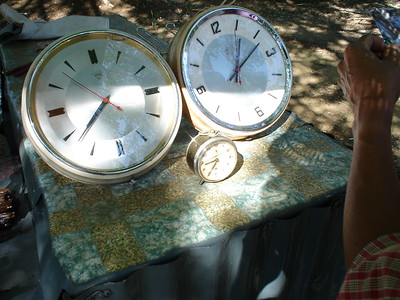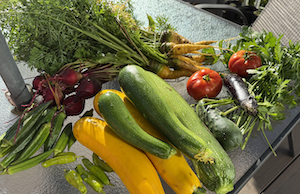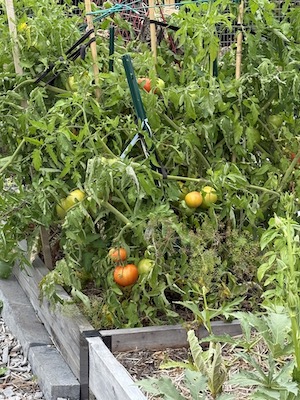Tempus fugit
The nice thing about high summer was that I could spend early morning and late afternoon into evening in the garden, and still have a full day of sunshine to do other stuff. There was a downside, of course (isn’t there always?): if I stayed in the garden until sundown, I wouldn’t get to eat dinner until 9:30 or 10:00. Unless I took the chips-and-salsa shortcut.

Tempus fugit
“Old Clocks” by servus is licensed under CC BY-SA 2.0
No dinner shortcuts needed now. The daylight hours trickled off slowly in July and early August. I could pretend that fall wouldn’t really happen. September has squelched that sweet illusion. I could swear that only a month ago I could pack up all the tools and close the veggie garden gate at 8:20 pm and not have to grope my way to the garage to put things away. Now, I’m actually swearing because I can see nothing outside by 6:45.
Just to make sure I wasn’t dreaming the loss, I looked it up. And yes, September sees an accelerating loss of suntime. In my slice of the globe, we’ve kissed goodbye about 80 minutes of daylight in these 30 days. Maybe not so bad when you learn that Alaska lost 193 minutes this month. But Alaskans know better than to try to garden in September, don’t they?
You don’t always reap what you’ve sown
The garden still produces, I grant you that. Weeds, of course, it produces in profusion, and every time I go in or out at the front of the house, they mock me with their hold on the perennial and shrub beds. As we all know, weeds can grow in the dark, or even in the split-second that you turn your back.
The plants you want, though? They’re another story. I put in the late-season veggies around mid-August. In June they might have zoomed to maturity in a month; in September they don’t inch along; they millimetre. And the chard can’t even grow fast enough to keep ahead of whatever bug has been chomping it. The cabbage moths had no trouble finding the yummy young kale. Wait till they find out there’s bok choi and chard in the next row.
 Granted, some of the summer plants keep producing. Earlier this summer I briefly toyed with the notion of keeping a record of the garden’s daily output. The cukes and zucchini soon disabused me of that fantasy. I can tell you the cukes’ output, roughly: 5 quarts of dill spears, 7 pints of bread-and-butter pickles, 5 pints of pickle relish, and a whole lot of salads. Mercifully, the cucumber vines have contracted some malaise that shrivels their leaves, and have about given up. The zucchini, however, continue their furtive progress. The yellow ones I can usually spot before they reach epic proportions, but every week or so it seems I locate a green one the size of a baseball bat that somehow eludes my notice until I trip over it.
Granted, some of the summer plants keep producing. Earlier this summer I briefly toyed with the notion of keeping a record of the garden’s daily output. The cukes and zucchini soon disabused me of that fantasy. I can tell you the cukes’ output, roughly: 5 quarts of dill spears, 7 pints of bread-and-butter pickles, 5 pints of pickle relish, and a whole lot of salads. Mercifully, the cucumber vines have contracted some malaise that shrivels their leaves, and have about given up. The zucchini, however, continue their furtive progress. The yellow ones I can usually spot before they reach epic proportions, but every week or so it seems I locate a green one the size of a baseball bat that somehow eludes my notice until I trip over it.
 And the beefsteak tomatoes, oh my! Dozens of green ones have weighted the plant down so much that I had to add stakes twice, and exhausted my supply of homemade ties. Some of the tomatoes oblige by turning red at two- or three-day intervals. But they aren’t all going to ripen fast enough to beat the first frost. By which point it’s green-tomato chutney time. I foresee multiple pints.
And the beefsteak tomatoes, oh my! Dozens of green ones have weighted the plant down so much that I had to add stakes twice, and exhausted my supply of homemade ties. Some of the tomatoes oblige by turning red at two- or three-day intervals. But they aren’t all going to ripen fast enough to beat the first frost. By which point it’s green-tomato chutney time. I foresee multiple pints.
Plotting along
But here’s my dilemma: with that produce burgeoning (don’t get me started on the beets, please), I should be spending more, not less, time in the garden (and in the kitchen cooking it up or freezing or canning). I should also be catching up on the weeds that got away from me in August (well, August and July and June). But the early mornings are uncomfortably cold for digging up encroaching crabgrass, and the early evenings end much earlier.
 I solaced myself by baking a couple of Italian prune-plum tortes one rainy morning. Those plums are only available for a short time every year, so it was now-or-never-ville.
I solaced myself by baking a couple of Italian prune-plum tortes one rainy morning. Those plums are only available for a short time every year, so it was now-or-never-ville.
One marvelous morning, I did get out front and thoroughly weeded one small bed, and piled on plenty of mulch. That bed looks great. It also made the rest of the beds look sleazy, unkempt, and ridiculous. My sister pitched in heroically to do a larger one, which looks even greater and makes the rest of the beds look, well, like somebody had better tend to them quick.
You might question my sanity when I tell you that in the midst of all this, I ordered several peony plants, which have got to go into brand-new, as-yet-nonexistent beds, by early November.
The power of the unpredictable
Just as my angst about the state of the garden was reaching frenzy pitch earlier this month, I had an accident that helped put things in perspective. I fell hard down the basement stairs, landed on my forehead, and ended up in the ER. Miraculously, nothing broke. I did need twelve stitches and carried a couple of huge deep-purple shiners around for about ten days. But the accident has slowed me down and made me a bit more reflective. As in, less inclined to think that any deficit in the garden spells the end of the world. I’m lucky to be alive; the rest is gravy.
And a good thing. The garlic and shallot babies just arrived. They have to go in in October.
Tomorrow is October.
If it were not for my accident, I’d panic. But panic never works in the garden anyway. I’ll do what I can. That’s all I can do.
If that’s not a motto for life, what is?
Your turn
If you haven’t already done so, you can sign up for the newsletter, which just gets you an e-mail when a new post goes up. Whether you sign up or not, please feel welcome to post your comments below. I try to reply to every comment, but feel free to answer others’ comments yourself, too. Go for any topic this post or gardening in general inspires you to.
If you’re commenting for the first time using a particular email address, your comment has to wait for my clearance (spam-thwarting at work there). After your first approved comment, your next should go up automatically. If you’re concerned about privacy, you needn’t include your surname. I am the only one who sees your email address.
If others post comments before you, the Reply box for your comment appears after their posts, so scroll down till you find it.
Thanks, as always, for reading, double thanks for responding, and triple thanks if you sign up for a subscription, or encourage a friend to do so.
